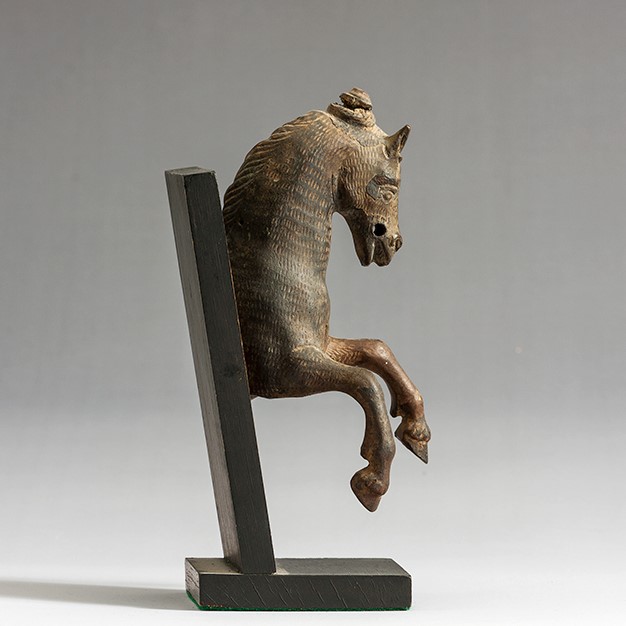Acquisition number: 1970.03
Forequarters of a horse. The facial features are done crudely but with lively effect. The mane falls to the left. The body and upper legs are covered with short incised strokes. At the top, at the highest point, is a pin to secure some object or vessel above. There is a hole 5mm. in diameter in the chest between the legs; there are three other small holes, ca 1mm. in diameter, one below the chest, another at the back of the right side of the neck, and the third on the top of the head between the ears. These must have been to secure the horse to a larger object.
Title: Bronze Protome of a Horse - 1970.03
Acquisition number: 1970.03
Author or editor: J.R. Green
Culture or period: Roman Imperial
Date: c. 2nd century AD.
Material: Metal - Bronze
Object type: Sculpture and figurines
Dimensions: 110mm (h)
Origin region or location: France
Origin city: Gaul or Britain.
Display case or on loan: 11
Keywords: Roman, Imperial, Gaul, Britain, Roman Gaul, Roman Britain
Folio Fine Art Ltd (London), Catalogue 72 (May 1970) no. 734 (ill.); Three Thousand Years of Classical Art (Exhibition Cat., Sydney, 1970) no. 71; J.R. Green with B. Rawson, Catalogue of Antiquities in the Australian National University, A.N.U. (Canberra, 1981) 99.
1970.03
Bronze Protome of a Horse
Purchased. Max. ht (hoof to head) 11cm.
The material is brass-like. The object is well-preserved and in good condition.
Forequarters of a horse. The facial features are done crudely but with lively effect. The mane falls to the left. The body and upper legs are covered with short incised strokes. At the top, at the highest point, is a pin to secure some object or vessel above. There is a hole 5mm. in diameter in the chest between the legs; there are three other small holes, ca 1mm. in diameter, one below the chest, another at the back of the right side of the neck, and the third on the top of the head between the ears. These must have been to secure the horse to a larger object.
The purpose of the figure is enigmatic but it possibly belonged to some sort of lamp-stand (for such objects, see H. Menzel, Antike Lampen [2nd ed., Mainz 1969] 106). The vigorous treatment and the incising of the surface suggest Gaulish or British manufacture: compare the dog, M.Wheeler, Roman Art and Architecture (London 1964) 217 (= J.M.C. Toynbee, Art in Britain under the Romans [Oxford 1964] pl. 34 b-c), or S. Boucher, Bronzes romains figurés du Musée des Beaux Arts de Lyon (Paris 1973) nos 239 and 246. See also H. Menzel, Die römischen Bronzen aus Deutschland. III. Bonn (Mainz 1986) pl. 141 no. 460, another horse protome from Cologne. It is very similar to ours, though less well finished.
For a useful treatment of Roman bronze figurines with good bibliography, see V. Galliazzo, Bronzi romani del Museo Civico di Treviso (Rome 1979)
The chronology of this sort of material is far from certain: perhaps second century AD.
Folio Fine Art Ltd (London), Catalogue 72 (May 1970) no. 734 (ill.); Three Thousand Years of Classical Art (Exhibition Cat., Sydney, 1970) no. 71; J.R. Green with B. Rawson, Catalogue of Antiquities in the Australian National University, A.N.U. (Canberra, 1981) 99.



